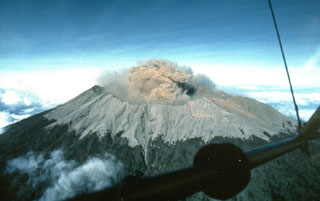Report on Raung (Indonesia) — 25 December-31 December 2024
Smithsonian Institution / US Geological Survey
Weekly Volcanic Activity Report, 25 December-31 December 2024
Managing Editor: Sally Sennert.
Please cite this report as:
Global Volcanism Program, 2024. Report on Raung (Indonesia) (Sennert, S, ed.). Weekly Volcanic Activity Report, 25 December-31 December 2024. Smithsonian Institution and US Geological Survey.
Raung
Indonesia
8.119°S, 114.056°E; summit elev. 3260 m
All times are local (unless otherwise noted)
The Pusat Vulkanologi dan Mitigasi Bencana Geologi (PVMBG) reported an eruption at Raung on 24 December. The eruption occurred at 0930 and lasted about four minutes and 42 seconds. A dense gray ash plume rose around 2 km above the summit and drifted E. The seismic network detected subsequent eruptive events at 1025, 1031, and 1035, though foggy weather prevented visual observations. According to the Darwin VAAC an ash plume from an eruption already in progress was identified in a satellite image at 1000 rising to 6.1 km (20,000 ft) a.s.l., or 2.8 km above the summit, and drifting NE. A second, discrete eruption plume was identified in a satellite image at 1050 rising to 7.9 km (26,000 ft) a.s.l., or 4.6 km above the summit, and drifting NW. The Alert Level remained at 2 (on a scale of 1-4) and the public was warned to stay 3 km away from the summit crater.
Geological Summary. Raung, one of Java's most active volcanoes, is a massive stratovolcano in easternmost Java that was constructed SW of the rim of Ijen caldera. The unvegetated summit is truncated by a dramatic steep-walled, 2-km-wide caldera that has been the site of frequent historical eruptions. A prehistoric collapse of Gunung Gadung on the W flank produced a large debris avalanche that traveled 79 km, reaching nearly to the Indian Ocean. Raung contains several centers constructed along a NE-SW line, with Gunung Suket and Gunung Gadung stratovolcanoes being located to the NE and W, respectively.
Sources: Pusat Vulkanologi dan Mitigasi Bencana Geologi (PVMBG, also known as CVGHM), Darwin Volcanic Ash Advisory Centre (VAAC)

